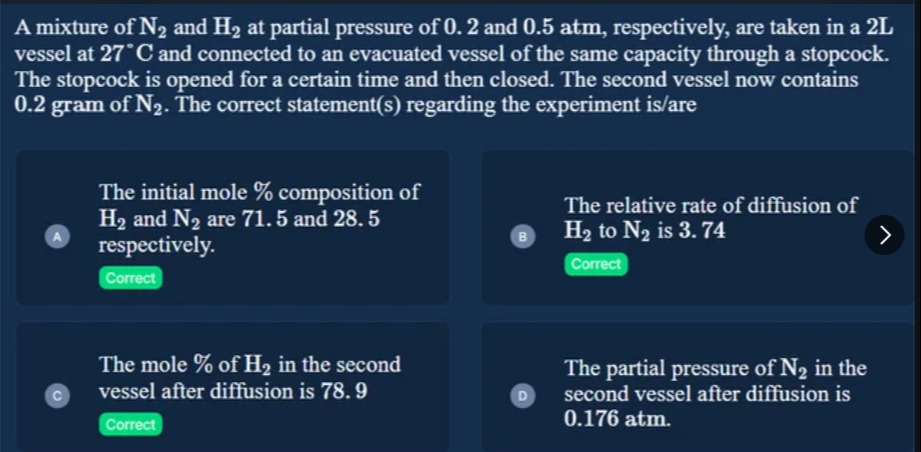Question
Question: A mixture of N2 and H2 at partial pressure of 0. 2 and 0.5 atm, respectively, are taken in a 2L vess...
A mixture of N2 and H2 at partial pressure of 0. 2 and 0.5 atm, respectively, are taken in a 2L vessel at 27°C and connected to an evacuated vessel of the same capacity through a stopcock. The stopcock is opened for a certain time and then closed. The second vessel now contains 0.2 gram of N2. The correct statement(s) regarding the experiment is/are

The initial mole % composition of H2 and N2 are 71.5 and 28.5 respectively.
The relative rate of diffusion of H2 to N2 is 3.74
The mole % of H2 in the second vessel after diffusion is 78.9
The partial pressure of N2 in the second vessel after diffusion is 0.176 atm.
A, B, C
Solution
Initial conditions: Vessel 1: V1=2 L, T=300 K, PN2,i=0.2 atm, PH2,i=0.5 atm. Vessel 2: V2=2 L, Initially evacuated. Molar masses: MN2≈28 g/mol, MH2≈2 g/mol.
Statement A: Initial mole % composition. Initial total pressure in Vessel 1, Ptotal,i=PN2,i+PH2,i=0.2+0.5=0.7 atm. Initial mole fraction of N2, xN2,i=Ptotal,iPN2,i=0.70.2=72. Initial mole % of N2 = 72×100≈28.57%. Initial mole fraction of H2, xH2,i=Ptotal,iPH2,i=0.70.5=75. Initial mole % of H2 = 75×100≈71.43%. The statement gives 71.5% for H2 and 28.5% for N2. These values are close to the calculated values (likely rounded). Correct.
Statement B: Relative rate of diffusion of H2 to N2. According to Graham's law, the rate of diffusion is inversely proportional to the square root of the molar mass. rN2rH2=MH2MN2=228=14. 14≈3.7416. The statement gives 3.74, which is approximately equal to 14. Correct.
Statement C: Mole % of H2 in the second vessel after diffusion. 0.2 grams of N2 diffused into the second vessel. Moles of N2 in Vessel 2, nN2,V2=28 g/mol0.2 g=1401 mol.
Assuming the intended model implies nN2,V2nH2,V2=MH2MN2=3.74. Then nH2,V2=3.74×nN2,V2=3.74×1401≈0.0267 mol. Total moles in Vessel 2 = nN2,V2+nH2,V2=1401+3.74×1401=1404.74 mol. Mole % H2 in Vessel 2 = ntotal,V2nH2,V2×100=4.74/1403.74/140×100=4.743.74×100≈78.9%. Statement C is correct under this assumption.
Statement D: The partial pressure of N2 in the second vessel after diffusion is 0.176 atm. PN2,V2=V2nN2,V2RT=2(1/140)×0.0821×300≈0.08796 atm. Statement D is incorrect.
Final Answer: A, B, C
